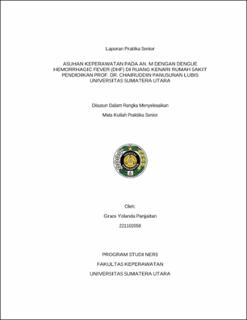| dc.description.abstract | Dengue Hemorrhagic Fever (DHF) is a disease caused by infection with one of four dengue virus serotypes with clinical manifestations of fever, pain (liver, muscles, joints), leukopenia, rash, lymphadenopathy, thrombocytopenia and hemorrhagic dysethesis. This study aims to apply the concept of nursing care in children with dengue hemorrhagic fever (DHF). This research was conducted using a case study method with a nursing process approach which includes: assessment, data analysis, nursing planning, implementation and evaluation. The nursing diagnoses that appear on An. M in accordance with data analysis there are 4, namely: Bleeding associated with thrombocytopemia, hypovolemia, acute pain and the risk of meeting nutritional needs less than body needs. After taking nursing actions, the results were found, the nursing problem of bleeding had been resolved characterized by, bleeding in the gums had stopped, petetike (-), malena (-). The nursing problem of hypovolemia is resolved characterized by, moist lip mucosa, Ht: 34%, TTV within normal limits. The problem of pain is resolved marked by the face grimace is absent, tenderness in the abdomen (-), pain scale 2. The nursing problem of the risk of fulfilling nutrients less than the body's needs is resolved marked by the child's appetite improving, portion eating habs no weight loss. The main principle of DFH management is supportive therapy, adequate supportive therapy will reduce patient mortality. | en_US |




